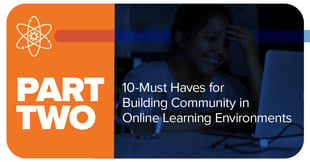Dr. Kathryn Kennedy has over 15 years of experience in online, blended, and digital learning in PreK-12, higher education, and beyond. Her work is focused at the intersection of research, practice, and policy. She owns and operates her own consulting firm that is currently helping inform PLTW’s current and future teaching and learning experiences.
Whether you are engaging online, face-to-face, or somewhere in between, community building is not only an art, it is a vital ingredient for cultivating meaningful learning environments. Specifically in an online learning environment like the one we are creating for PLTW Core Training this summer, building community is even more critical because you’re not physically in the same location as the rest of your fellow learners and training facilitators. To that end, we have built the PLTW Core Training experience upon a foundation focused on community building.
Of what does that foundation consist, you ask? The foundation consists of 10 must-have components, that we will share in this two-part series.
1. Design and develop a clearly structured and supportive learning environment. First and foremost, a community needs a learning environment that is clearly structured for maximum support. Think critically about how to structure the environment so that the learner is clear about navigation from activity to activity and about where they can interact and collaborate with their facilitators and fellow learners. Providing learners with clear learning goals, objectives, agenda, and expectations can provide much-needed guidance. Choosing technologies that learners are familiar with is ideal when possible.
2. Employ passionate, present, and active facilitators. Having a facilitator who is present and engaged in the learning process helps tremendously in motivating learners. A passionate facilitator sends meaningful communication to their learners and fosters engagement, interaction, and collaboration between themselves and the learners, as well as between learners and other learners. A present facilitator provides feedback in a timely manner and welcomes and incorporates feedback from their learners to iteratively better the learning experience. Facilitators should also provide clear communication expectations, including when and how learners have access to them. Building relationships with learners is necessary for facilitators to cultivate a supportive community.
3. Build in opportunities for learner voice and choice. In any learning environment, empowering learners with voice and choice is essential to building community. A community should support learners’ interests and passions so that every learner can be comfortable expressing who they are and what they stand for. Encourage learners to take ownership of their learning and contribute their ideas, experiences, and expertise. Provide opportunities for learners to reflect together around the authentic application of what they’re learning. Regularly survey learners informally for preferences and grouping purposes so that learners know that they are being heard. When learners feel like they are heard, when they feel like they belong, and when they feel like they matter, their investment in the vision of the community grows, and they are motivated to help others for the greater good.
4. Create a safe and supportive space. When learners are in a safe space, they feel free to share ideas, including differences of opinion and perspective, without fear of criticism. Establishing “netiquette” (etiquette for the internet) norms with learners is essential for creating a safe and respectful learning environment. Some netiquette norms include but are not limited to:
- Set a respectful tone—respect other people’s opinions and perspectives—be kind and professional.
- Don’t use ALL CAPS BECAUSE OTHERS WILL THINK YOU’RE YELLING AT THEM ;-).
- Take time to read before you post so that you contribute something new to the discussion rather than repeat what has already been said.
- When posting in discussion forums, ask peers follow-up questions or try to extend the conversation beyond agreeing with your peer’s statements.
- If you disagree with someone’s opinion, do so in a respectful way, and explain why you disagree with them, offering credible references and resources to uphold your stance.
- Raise your virtual hand during live sessions when you have something to say or a question to ask instead of interrupting someone who is speaking.
- Give options for breaks.
5. Be fluid and flexible based on the needs of the learners and the learning environment. While providing a strong structure to support the learning experience, being fluid allows for more flexibility for just-in-time changes to be implemented to better meet the needs of the learners and the learning environment. For instance, in some cases, you might choose to provide additional resources for those who might finish early and factor in time for additional guidance for those who need more support.
Using these must-have, research-based best practices to inform design and development work is critical to ensure a thriving community in online learning environments. Launching in just a few short weeks, PLTW Core Training incorporates these 10 must-haves. Our team has spent March, April, and May working diligently to translate the face-to-face PLTW Core Training into online learning experiences.
PLTW’s dedication and commitment to offering high-quality, dynamic, interactive, and collaborative experiences through its many face-to-face professional learning opportunities is being maintained as we transition this learning online. To be clear, our transition to online learning is less about the technology and more about the relationship and community building that we will continue to engage in with our learners in this new learning environment. We are so excited to welcome you to the trainings, and we look forward to seeing you there!
Click here to read Part Two of this series, which includes components 6-10.
Jonassen, D., et al. (2008). Meaningful Learning with Technology (3rd ed.) Upper Saddle River, NJ: Pearson Education.
Moore, M. G. (2013). Chapter 2. Handbook of Distance Education (3rd ed.). New York: Lawrence Erlbaum Associates.
PLTW’s blog intends to serve as a forum for ideas and perspectives from across our network. The opinions expressed are those of each guest author.


